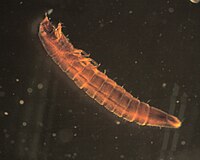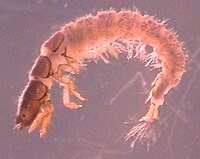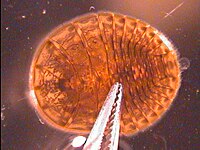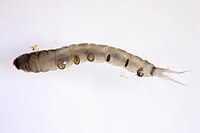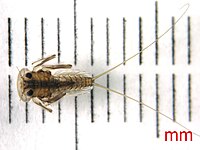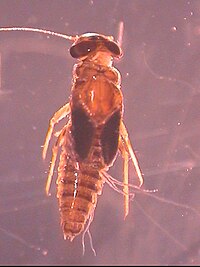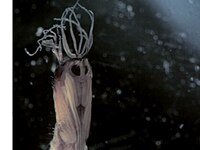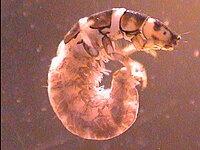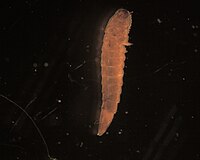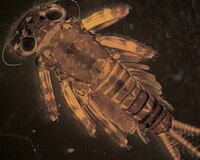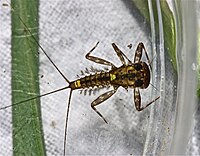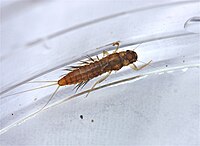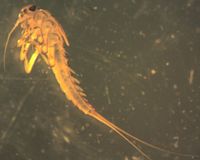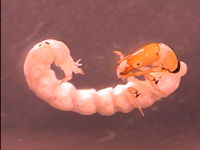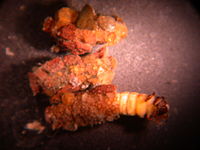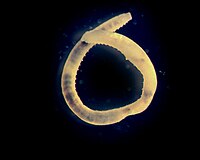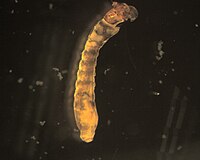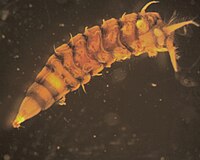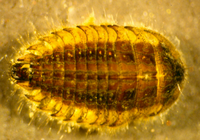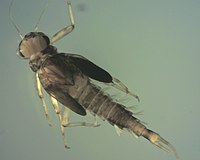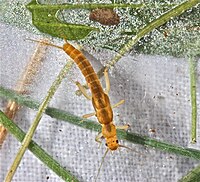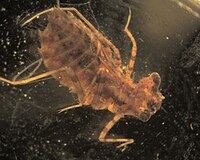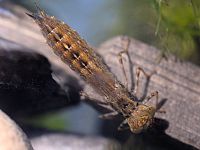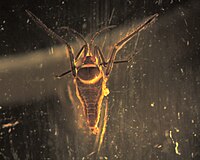Vermont EPSCoR's Streams Project; A Teacher Collaboration on WikiEducator
Openly shared content, practices, and developing resources from Vermont EPSCoR's Streams Project. Join this collaboration and make a difference!
 Mud Creek 731 |
|---|
|
| Stream code: | MR_MudCrk_731 |
| Basin: | Missisquoi Basin |
| State or Province: | Vermont |
| Country: | USA |
| Latitude: | 44.95342 |
| Longitude: | -72.31878 |
| School: | United Christian Academy |
The following are the most common invertebrates collected from this stream site.
Chironomidae
- Order
- Diptera
- Family
- Chironomidae
- Common name
- Nonbiting midge
- Tied fly
- Griffith's Gnat
Midge larvae tend to be the most common macroinvertebrate at our sites. As with other Diptera, there are no true jointed legs. Chironomidae do have a pair of prolegs at each end and preserved individuals tend to curl into a 'C'. Identification past family requires slide-mounted heads. We have seen philopotamid caddisflies misidentified with the chironomids and we suspect that that happens when samples are being sorted from trays. Under a microscope, six prominent legs can be seen on members of the caddisfly family Philopotamidae.
More information on Philopotamidae.
Stenelmis
- Order
- Coleoptera
- Family
- Elmidae
- Genus
- Stenelmis
The larvae of
Stenelmis, as in
Ordobrevia, have a sternum on the ventral side of the pronotum. The main difference between the two genera is in the antennae the second segment is less than twice as long as the first in
Stenelmis.
The adult Stenelmis has a clear separation between the thorax and abdomen as well as a more distinctly separate head as compared to other genera.
Click here to see pictures of the sternum and
antennae-
Template:Ordobrevia
Cheumatopsyche
- Order
- Trichoptera
- Family
- Hydropsychidae
- Genus
- Cheumatopsyche
Cheumatopsyche has a
forked foretrochantin (as does
Ceratopsyche). The foretrochantin is the projection at the uppermost portion of the front leg closest to the head. The leg may need to be pulled away from the body to expose this feature.
Cheumatopsyche have a small or inconspicuous
pair of sclerites under the prosternal plate that are difficult to see. Contrast that with the
larger pair of sclerites found on Ceratopsyche. To access sclerites, it's best to gently pull the pronotum and mesonotum in opposite directions. Note: the large single sclerite is the prosternal plate.
Cheumatopsyche have only 2 types of
hair on the abdomen: long thin plain hairs and thicker club hairs, which are narrow close to the body and widen out at the distal end. Paired sclerites on the ninth abdominal segment are notched.
Psephenus
- Order
- Coleoptera
- Family
- Psephenidae
- Genus
- Psephenus
The true "water penny" is commonly found in the waters sampled.
Psephenus has a rounded shape with relatively smooth edge. The
false water penny, whose edges are serrated, has a more oval appearance. The
gills on the ventral surface are found only in the true water pennies.
Another genus encountered in this family is Ectopria.
Antocha
- Order
- Diptera
- Family
- Tipulidae
- Genus
- Antocha
This small dipteran in the cranefly family is quite common. It is distinguished from most other dipterans we found by the 'creeping welts' that appear as prominent dark stripes along the abdomen. The dark head is usually partly exposed; however, it can be pulled back into the thoracic cavity during preservation.
Heptageniidae
- Order
- Ephemeroptera
- Family
- Heptageniidae
- Common name
- flatheaded mayfly
- Tied fly
- Light Cahill, Wingless Pale Evening Dun
This family of mayflies can be characterized by their distinctly flattened heads and striking resemblance of the character 'Jack Skellington' from the movie 'The Nightmare Before Christmas.' This family can either have two or three cerci (tails).
Commonly encountered genera include:
Epeorus
Heptagenia
Maccaffertium
Rhithrogena
Leptophlebiidae
- Order
- Ephemeroptera
- Family
- Leptophlebiidae
- Common name
- pronggill mayfly
Diptera
- Order
- Diptera
- Tied fly
- Griffith's Gnat
Pupae from the order Diptera are typically found in small numbers at every site. These can be identified further, but we do not.
Ceratopsyche
- Order
- Trichoptera
- Family
- Hydropsychidae
- Genus
- Ceratopsyche
Ceratopsyche has a
forked foretrochantin. The foretrochantin is the projection at the uppermost portion of the foreleg. The leg may need to be pulled away from the body to expose this feature.
Ceratopsyche have a
large pair of sclerites underneath the prosternum. Note: the large single sclerite is the prosternal plate. Biologists have gone back and forth between lumping this genus into
Hydropsyche and splitting it back out. ITIS currently lists it as a genus (Feb 2013) but we are aware of a recent paper that lumped it under
Hydropsyche.
Optioservus
- Order
- Coleoptera
- Family
- Elmidae
- Genus
- Optioservus
The larvae of
Optioservus have open coxae, as determined by the straight definition between segments on the ventral side of the pronotum.
The adult Optioservus have a compact appearance, especially the head and thorax. There are also dorsal ridges and a characteristic diamond-shaped sutellum observable in the dorsal view.
Images of the straight definition between segments, the dorsal ridgesand the diamond-shaped scutellum.
Maccaffertium
- Order
- Ephemeroptera
- Family
- Heptageniidae
- Genus
- Maccaffertium
- Common name
- The March Brown
- Tied fly
- March Brown
This genus of
Heptageniidae is distinguished by its gills on the seventh abdominal segment, which are reduced to slender filaments. Gills on segments 1-6 are truncated.
Images of the slender filaments, and the truncated gills.
Heptagenia
- Order
- Ephemeroptera
- Family
- Heptageniidae
- Genus
- Heptagenia
- Tied fly
- Little Graywinged Olive
Heptagenia are easily characterized by their flat head. The claws have just one basal tooth and no denticles (serrated edges). The gill on abdominal segment 7 has multiple fibrils at is base (thread-like structures) and has a single tooth on its claws but is smooth otherwise. Gills on segment 7 are similar to those on all other segments, but may be smaller in size.
Paraleptophlebia
- Order
- Ephemeroptera
- Family
- Leptophlebiidae
- Genus
- Paraleptophlebia
- Common name
- The Blue Quill
- Tied fly
- Blue Quill
Leptophlebiidae have forked, tufted, or fringed gills.
Paraleptophlebia typically have labrums less than 1/2 as wide as head anteriorly, which is considered "shallow." There are minute spinules present on posterior margins of abdominal terga 1-10.
Image of the forked, tufted, or fringed gills.
Baetis
- Order
- Ephemeroptera
- Family
- Baetidae
- Genus
- Baetis
- Common name
- The Little Olive
- Tied fly
- Sawyer Pheasant Tail Nymph
This mayfly has three "tails" and a unique head shape. Its gills are oval shaped and insert dorsally. More mature nymphs have long, dark wing pads.
Image of the long, dark wing pads.
Hydropsychidae
- Order
- Trichoptera (caddisfly)
- Family
- Hydropsychidae
- Common name
- net spinning caddisfly
- Tied fly
- Emergent Sparkle Pupa, Vermont Hare's Ear
This family of net-spinning caddisflies is very abundant at several sites. They are important filtering collectors and are quite common at urban and agricultural sites where particles of organic material can be important food resources. Genus-level identification is possible for mature specimens and we will include the genera we found at your site if possible.
When using the key, some features that are challenging to see are the forked trochantin and the paired sclerites in the folds between segments. Other, more easily seen key features include filamentous gills on the abdominal segments and the sclerotization of the dorsal surfaces of all three thoracic segments. Keep in mind that with smaller or more immature specimens, genus-level ID may not be possible.
Commonly found genera include Cheumatopsyche, Ceratopsyche, and Hydropsyche. Less commonly, we have found Arctopsyche and Potamyia.
Images of the forked trochantin and the paired sclerites.
Chimarra
- Order
- Trichoptera
- Family
- Philopotamidae
- Genus
- Chimarra
Chimarra are distinguished from the other Philopotamidae by a prominent asymmetrical notch in the frontoclypeus as well as a prominent process on the femur which bears a single hair (seta).
Images of the asymmetrical notch and prominent process.
Neophylax
- Order
- Trichoptera
- Family
- Uenoidae
- Genus
- Neophylax
- Common name
- Fool's Caddis
- Tied fly
- Peeping Caddis
Neophylax are characterized by having a sclerotized pronotum and mesonotum. They build a case of coarse sand grains often with a pair of latteral pebbles or "ballast stones". The larvae are rather stout and the head is scrunched in between the limbs. The anal hooks are attached directly to the abdomen and they rarely come out of the case when preserved. On the ventral surface of the abdominal segments, one can see darkened ovals, known as the chloride epithelia. Like the
Limnephilidae, they have a prosternal horn, though it can sometimes be small. Also, they have a dorsal hump and two lateral humps on the first abdominal segment- be careful! Often times, these features can be
squished down or damaged in the sampling process. A larva removed from it's case is shown
here.
The feature that distinguishes Uenoidae from Limnephilidae is the mesonotum: on either side of the midline, the anterior margin is notched.
Because our samples were taken in summer, we found large numbers of Neophylax pre-pupae. We anticipate that there will be fewer present in the streams in late September and many of those sampled will be at the pupal or adult stage. Samples taken in October would tend to have more empty cases.
Oligochaeta
- Common name
- aquatic earthworms; black worms
Aquatic earthworms lack legs and are characterized by having 20 or more segments. Unlike leeches, they lack a suction disk. We collect members of two or more orders in this class as small numbers of stream sites and they are rarely numerous. They are more common at pond and lake sites.
Image of the 20 or more segments.
Simuliidae
- Order
- Diptera
- Family
- Simuliidae
Simuliidae appear rather like bowling pins with heads. Relatively speaking, we collect few members of this family and have we have not identified them past family at this point.
Click here for a close up image of the heads.
Athericidae
- Order
- Diptera
- Family
- Athericidae
- Common name
- water snipe flies
Members of the family Athericidae have wrinkled bodies with prolegs on the ventral side. Their mandibles- which can be seen by carefully cutting the head open- move parallel to each other. On the end of their abdomen there are two lobes fringed with setae. Our collections include just the single genus Atherix.
Image of the two lobes of the abdomen.
Ectopria
- Order
- Coleoptera
- Family
- Psephenidae
- Genus
- Ectopria
False water pennies are less circular than true water pennies, and come to a blunt point at the back end. They appear to have serrated edges and lack gills.
Another genus encountered in this family is Psephenus.
Acerpenna
- Order
- Ephemeroptera
- Family
- Baetidae
- Genus
- Acerpenna
- Common name
- Tiny blue-winged olive
This genus is can be identified by the costal process, or projection, distal to the hind wing pad. Gill 7 is slender and may be pointed at the end. The antennal scape and pedicel have a few scattered setae (hairs).
Image of the antennal scape. A ventral view can be seen here.
Leuctra
- Order
- Plecoptera
- Family
- Leuctridae
- Genus
- Leuctra
This family of stonefly is fairly slender by stonefly standards. The divergent wing pads are a helpful characteristic. Leuctridae are similar in overall shape to the Capniidae; however, Leuctridae often do not have pleural folds. If they are present, they only extend from abdominal segments 1-7.
Leuctra are recognized by abdominal terga with posterior fringes of short hairs and last few segments with longer hairs.
Image of the divergent wing pads.
Libellulidae
- Order
- Odonata
- Family
- Libellulidae
- Common name
- Skimmer
These dragonfly larvae (sub-order Anisoptera) can be distinguished from damselfly larvae (sub-order Zygoptera) by their more robust bodies and an abdomen that ends in five 'spikes' as opposed to three gills. The family Libellulidae is characterized by their spoon-shaped mouthparts.They are distinguished from the other family with this trait, Cordulegastridae, by the small rounded teeth on the edges of their palpal lobes.
Images of the spoon-shaped mouthparts, and the small, rounded teeth.
Aeshnidae
- Order
- Odonata
- Family
- Anisoptera
- Common name
- Darner
- Tied fly
- Carey Special
All dragonflies have five points sticking out from the back end. Members of this family of dragonflies are distinctly long as can be seen in the photograph. Other common families tend to be a wider and flatter. If you pull out on the mouthparts under the head you'll see that they look flat in side view. If they look spoon-shaped then it is from a different family. Like other
Odonata, members of this family have four wingpads. Like members of the sub-order
Anisoptera, the abdomen terminates in five points. The prementum and palpal lobes of this dragonfly are flat when viewed from side.
Images of the four wingpads, the abdomen, the prementum and palpal lobes, and a view from the
the side.
Veliidae
- Order
- Hemiptera
- Family
- Veliidae
This family of Hempitera actually lives on the surface of the water, but can sometimes float into the net while taking benthic samples. Members of the family Veliidae are characterized by the claw of the foreleg; it is inserted before the apex. Also, its hind leg has a beautiful fan of hydrofuge hairs.
Click here to see the claw inserted before the apex and the fan of hydrofuge hairs.


